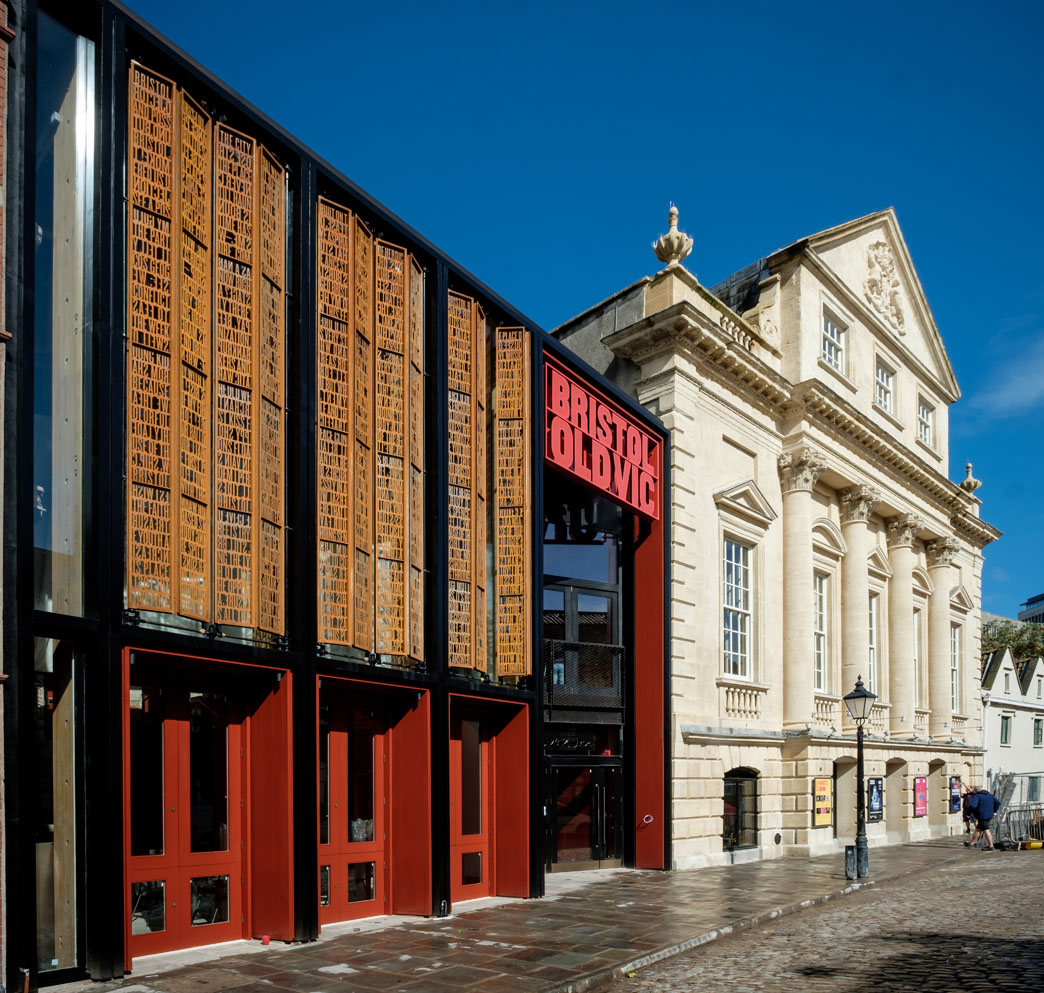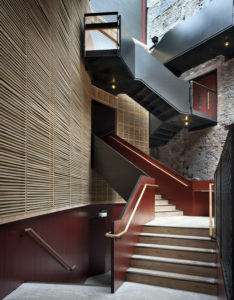 A large crowd assembled on King Street, Bristol tonight eagerly awaiting the much-anticipated opening of the Old Vic redevelopment. Three members of RSVP Bhangra and fire jugglers from the Invisible Circus brought a party vibe to the street before Director Tom Morris announced the opening of the new building. Metal shutters featuring the words of David Garrick and Bristol Poet Laureate Miles Chambers were wound open as a film about the history and redevelopment of the site was projected onto a giant sheet suspended behind the glass windows. At its conclusion, actor Simon Callow did the honours, pulling the sheet down to allow the crowd to see the spot and candlelit original wall of the Old Vic, exposed for the first time in 250 years.
A large crowd assembled on King Street, Bristol tonight eagerly awaiting the much-anticipated opening of the Old Vic redevelopment. Three members of RSVP Bhangra and fire jugglers from the Invisible Circus brought a party vibe to the street before Director Tom Morris announced the opening of the new building. Metal shutters featuring the words of David Garrick and Bristol Poet Laureate Miles Chambers were wound open as a film about the history and redevelopment of the site was projected onto a giant sheet suspended behind the glass windows. At its conclusion, actor Simon Callow did the honours, pulling the sheet down to allow the crowd to see the spot and candlelit original wall of the Old Vic, exposed for the first time in 250 years.
Once inside we were encouraged to explore our new surroundings as singer Jon Boden from Bellowhead sang from an opening high above us. A new bar and ticket office sat in an imaginatively lit space that featured multiple staircases and levels to left and right under an imposing ceiling crisscrossed with timbers. Events manager Jasmine Collins kindly took me and fellow StageTalk Magazine reviewer Graham Wyles on a tour of the new facilities which included a restoration of the Grade I listed Coopers Hall, a new meeting room facility – the Foyle Room, and a completely reimagined and refurbished Studio Theatre. Working with partners Fosters Events, the Bristol Old Vic can now offer bespoke event hospitality as well as build on its established theatre credentials. The future looks bright. Simon Bishop 23rd September 2018
 A full-height timber and glass-fronted foyer, revealing the original auditorium façade to the street for the first time, acts like a covered public square. Huge sun-shading shutters, incorporating the text of Garrick’s inaugural 1766 address and a poem by former Bristol city poet Miles Chamber, highlight the theatre’s long history and look forward to its future role in the whole community. The foyer provides an inspiring place for the local community to enjoy throughout the day as a café, bar and meeting place.The internal layout has been completely transformed, with the restoration of the Georgian Coopers’ Hall as a public assembly room for Bristol, a new studio theatre created in the old barrel vaults, mezzanine galleries, winding staircases and viewing platforms. Together, they provide new flexible spaces for productions, events, experimental theatre and city-wide participation.
A full-height timber and glass-fronted foyer, revealing the original auditorium façade to the street for the first time, acts like a covered public square. Huge sun-shading shutters, incorporating the text of Garrick’s inaugural 1766 address and a poem by former Bristol city poet Miles Chamber, highlight the theatre’s long history and look forward to its future role in the whole community. The foyer provides an inspiring place for the local community to enjoy throughout the day as a café, bar and meeting place.The internal layout has been completely transformed, with the restoration of the Georgian Coopers’ Hall as a public assembly room for Bristol, a new studio theatre created in the old barrel vaults, mezzanine galleries, winding staircases and viewing platforms. Together, they provide new flexible spaces for productions, events, experimental theatre and city-wide participation.
The fascinating history of the oldest continuously-running theatre in the English-speaking world is also being opened up to the public for the first time as it becomes a new heritage destination later this autumn (November). Exhibitions, interactive experiences, tours and workshops will shine a light on the amazing stories of a playhouse that has been entertaining Bristol for over 250 years.
 This major project is the second stage of a ten-year £26 million programme to completely overhaul and safeguard the future of this historical and cultural gem, led by Artistic Director Tom Morris and Chief Executive Emma Stenning. They originally embarked on the challenge when they arrived at the theatre nearly 10 years ago, after it had been threatened by closure.
This major project is the second stage of a ten-year £26 million programme to completely overhaul and safeguard the future of this historical and cultural gem, led by Artistic Director Tom Morris and Chief Executive Emma Stenning. They originally embarked on the challenge when they arrived at the theatre nearly 10 years ago, after it had been threatened by closure.
With the aim of returning it to its original roots as a theatre for the whole city, the latest physical transformation complements the theatre’s ambitious Year of Change programme, which has seen it re-engage with communities across Bristol.
Tom Morris, Artistic Director at Bristol Old Vic, said: “We are inviting the amazing people of Bristol to become part of an exciting new era for the theatre. When it was first built in 1766, the theatre was a space where people from every walk of life would congregate to be inspired and entertained. Over 250 years, as fashions changed and the theatre became increasingly hidden from public view, Bristol Old Vic may sometimes have seemed to only belong to the privileged few.
“With this transformation, we are returning the theatre to its origins as a place for all and a new welcoming space where everyone can feel at home. The theatre will play a new role in bringing communities together, offering people a place to come together and socialise, as well as providing visitors with the chance to delve into its fascinating history through our new unique heritage experience.”
Emma Stenning, Chief Executive at Bristol Old Vic, added: “We’d urge anyone who’s interested in seeing what has been going on behind the hoardings for the past two years to come and find out more about this inspiring new space when we throw open our doors. They can meet the team responsible for the transformation, tour around the building and find out more about how and why the theatre is changing.”
Bristol Old Vic’s ‘Year of Change’ has been designed to renew its relationship with communities in Bristol, both as a place of entertainment and as a place where the most important concerns of the day can be explored, contested, discussed and understood. It has formed the inspiration for the theatre’s 2018 season, with each production exploring different aspects of human change.
Tom Morris added: “In a challenging time for regional theatre, this major redevelopment marks the launch of a new business model for the theatre and the renewal of its unique relationship with the city, with a radical programme presented that not only entertains, but also reflects the topics that people here care about most.”
Bristol Old Vic, the place where the likes of Daniel Day-Lewis, Kwame Kwei-Armah, Greta Scacchi, Peter O’Toole and Jeremy Irons once honed their craft, has a unique place in British theatre history. Known as the finest example of Georgian theatre in existence, it has only survived to its remarkable age through a mixture of luck, economic accident and the extraordinary passion of the people of Bristol who have rallied around to keep it alive whenever it seemed in jeopardy.
The theatre’s fascinating history will be opened to the public for the first time when it becomes a new heritage destination on November 9th. Exhibitions, interactive experiences, tours and workshops will shine a light on the amazing stories of a theatre that has been entertaining Bristol for over quarter of a millennium. Highlights include an interactive experience exploring the history of the creation of sound in the theatre, including a chance to see the 18th-century Thunder Run, an ancient contraption that simulates the sound of thunder above the auditorium. Visitors will also be able to view the changing face of the foyer over the centuries via an augmented reality app, whilst the rich history of the theatre will be charted through artistic timelines.
Interior photos by Philip Vile
Exterior picture by and @Jon Craig

